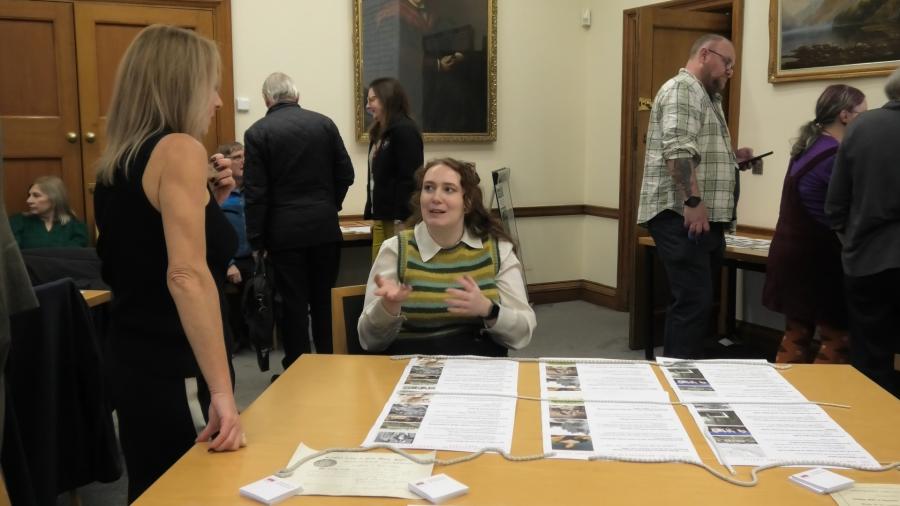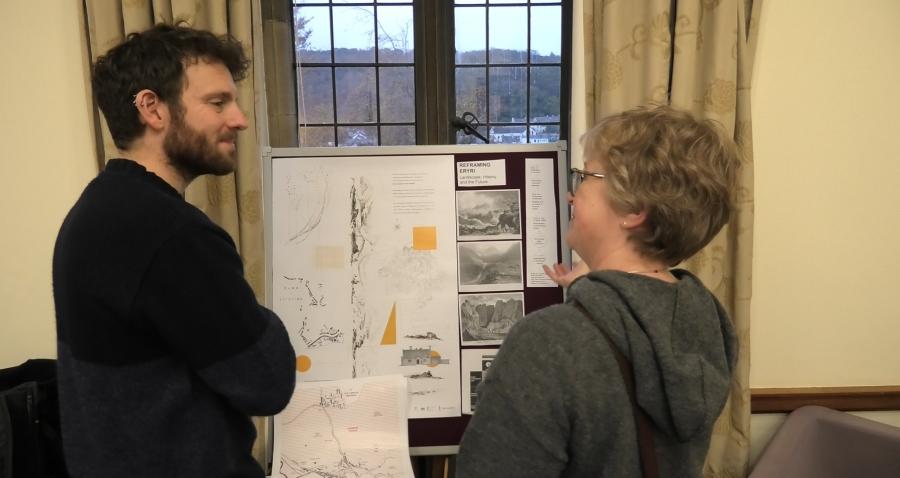A Celebration of Welsh History, Research and Community Connections
On 30th October 2024, Bangor University’s Cledwyn Conference Room 3 was abuzz with energy as the Institute for the Study of Welsh Estates hosted its first Community Day.
The event was a resounding success, providing a valuable opportunity for ISWE’s doctoral cohort to engage with the public and share insights into their research on Welsh estates, country houses, landscapes, politics, heritage and society through captivating displays and interactive discussions.

The room was bustling with enthusiasm as visitors explored a range of exhibitions that highlighted the breadth and depth of ISWE’s work. Among the standout projects were Vic Tyler-Jones’s exploration of squatter settlements on Newtown Mountain, offering a glimpse into the resilience of rural communities, and Lizzy Walker’s research on landowning and landholding women in north-east Wales, which shed light on the often-overlooked contributions of women to rural history. Bethan Scorey’s detailed display on the architecture of St. Fagans Castle traced its evolution and cultural significance, while Anna Reynolds provided insights into upland settlements of the Carneddau mountains. Alex Ioannou’s work on landscape history and climate change in the Eryri National Park emphasized the importance of understanding historical contexts in addressing contemporary environmental challenges. Jeff Childs presented his research on the Lordship of Gower and changes in landownership between 1750 and 1850, offering a nuanced view of evolving property rights and social structures. Meanwhile, Sara Fox’s exhibition on fictional representations of the gentry house in Wales explored the cultural and literary significance of these spaces in shaping perceptions of Welsh identity.

Throughout the day, attendees had the chance to engage with these fascinating projects in an informal and welcoming setting. The displays sparked lively conversations as members of the public, students, and university colleagues delved into the stories behind the research. Many of the researchers also brought along historical artefacts, offering visitors a tangible connection to the material culture of their case studies and adding depth to the exhibitions. ISWE’s commitment to making academic work accessible and engaging was evident, with many visitors expressing appreciation for the opportunity to learn more about the Institute’s mission and the pivotal role of Welsh archives in supporting its research.
Another highlight was the pop-up exhibitions that were dotted around the room, fostering further engagement. One which caught the eye was the Deep Mapping Estate Archives project, an innovative collaboration between ISWE and the Royal Commission on the Ancient and Historical Monuments of Wales (RCAHMW). This project, which uses digital tools to uncover the layers of history embedded in Welsh landscapes, drew significant interest and underscored ISWE’s commitment to combining traditional research with cutting-edge technology. Dr Matthew Rowland, who completed his PhD with ISWE a couple of years ago, brought an exhibition focusing on his current work with Denbighshire Heritage at Nantclwyd y Dre, and Dr Meinir Moncrieffe displayed a fantastic collation of primary sources linked to her PhD thesis on the Wynns of Gwydir. Dr Dinah Evans discussed her recent project at the University Archives cataloguing the papers of Lady Augusta Mostyn, and Dr Lowri Ann Rees had a selection of letters from her new publication on the Rebecca Riots.

In addition to the academic displays, the Community Day offered fun activities for all ages. Children enjoyed a crafts centre, including an opportunity to make a model of the house (Ynysmaengwyn) featured on the ISWE logo, while adults took part in a quiz (‘Identify the Country House’), informal discussions and explored interactive exhibits. The atmosphere was one of joy and curiosity, with laughter and animated conversations filling the room.
The event also provided a valuable networking opportunity for the doctoral researchers, who connected with partner organisations, local historians, members of ISWE’s Advisory Board and several former PhD researchers who retuned to Bangor especially for the event. It was a chance to forge new relationships and strengthen existing ones, all within the friendly and supportive environment that has come to define the Institute’s work.
Feedback from attendees was overwhelmingly positive, with many praising the day’s inclusive and engaging atmosphere.
The Community Day was followed in the evening by a fantastic Bangor University Archives and Special Collections Annual Lecture. The visiting Professor Terence Dooley, Director of the Centre for the Study of Historic Irish Houses and Estates, at Maynooth University, and a key supporter of the Institute, congratulated ISWE on the “tremendous strides” that they have made in the last few years, adding that “ISWE is a credit, not just to the department and the faculty, but to the wider institution, and its work is now known far and wide, and long may that continue.” The success, public interest and engagement of the Community Day emphasised ISWE’s dedication to fostering a sense of community and making research accessible to wider audiences.
The 2024 ISWE Community Day was a true celebration of research, collaboration and Welsh heritage. It not only highlighted the achievements of the doctoral cohort but also reinforced the Institute’s role as a vibrant intellectual community. For all who attended, it was a triumph – and a sign of even greater things to come.
(Authored by Dr Sean Martin)

